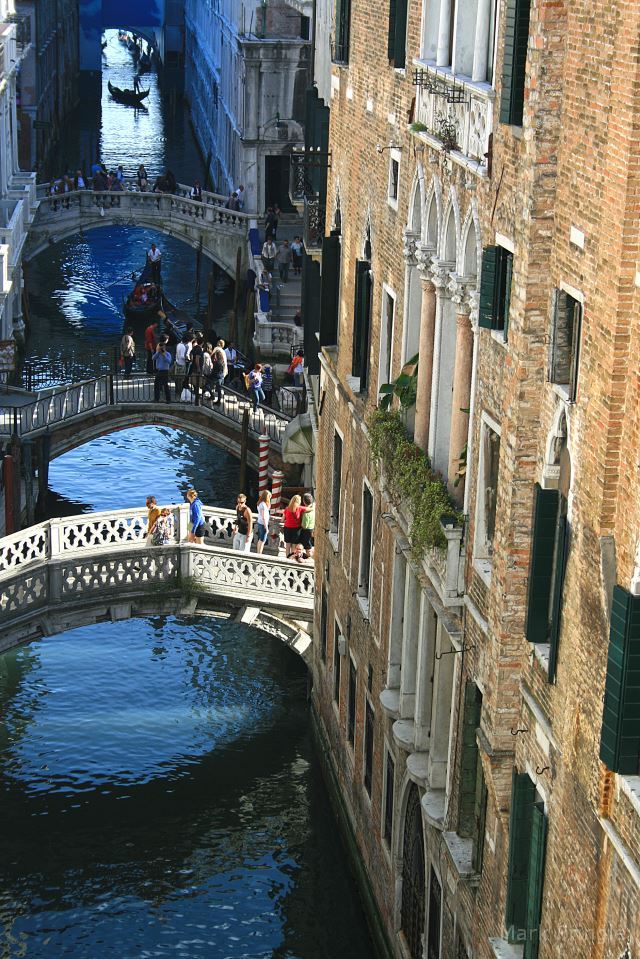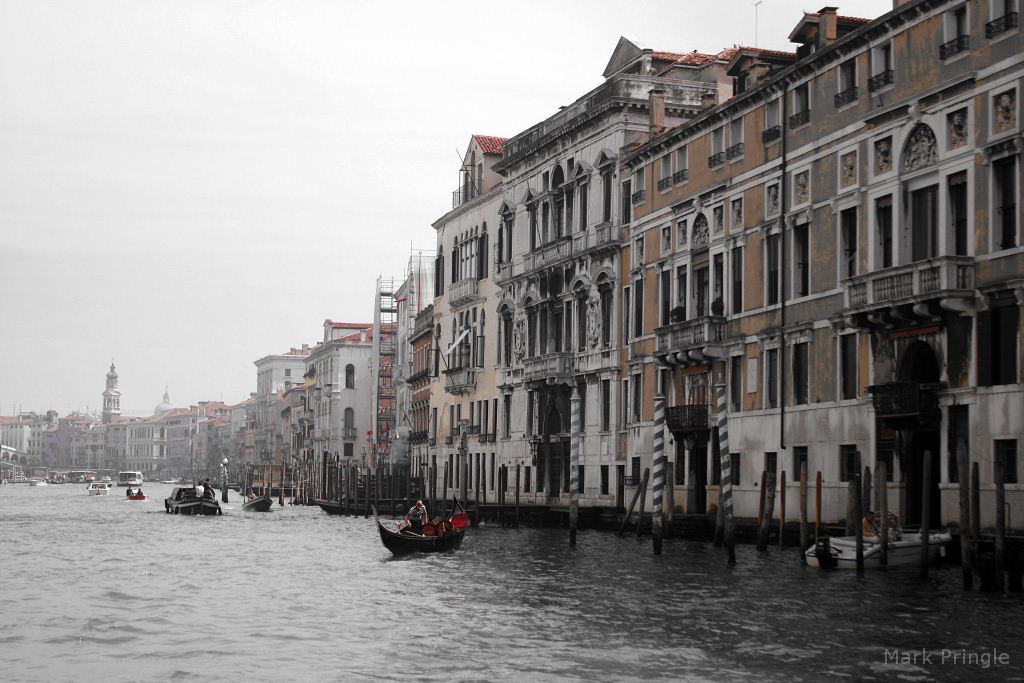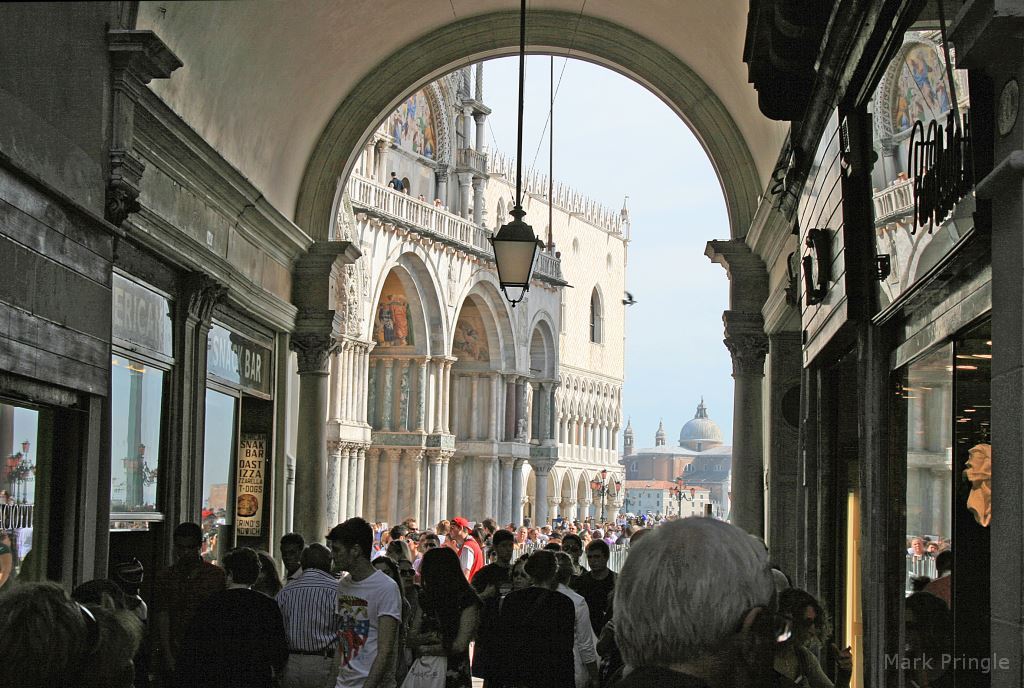It was Venice, the City of Canals and the Queen of the Adriatic, in a nutshell. It was a simple image I remember photographing out of our hotel room window. See, this was the end of a long and frenzied 10-day trip to Italy that encompassed the Amalfi Coast, Rome, Florence, and now Venice. Since this was our last stop, my wife and I rented a rather upscale hotel room, near Saint Mark's Basilica, for our brief stay in Venice. The room was on the fourth or fifth floor and located in the heart of Venezia. Some-time after we arrived and settled into our room, I took out my camera (first things first) and went unwaveringly to the window. That’s what you do when you check into a hotel, right? You go directly to your hotel window to see what sights are available from that perspective?
 The view from our hotel room.
The view from our hotel room.
As I looked out the window, hypnotic views abounded: deep black-cerulean canals, sculpted edifices, pastel-colored buildings, white stone bridges, and curious people. There are no streets in Venice. Well, I guess that’s just a matter of semantics because a canal can be considered a street in the academic sense of the word. However, these watery “streets” are a little more difficult to traverse than the typical paved ones. Nonetheless, Venice has a myriad of winding, maze-like, paved walkways which take you into, around, and through this wonderfully unique city. These paved passageways, not the canals, are the real "streets" of Venice.
But back to the image. It was a simple one but summed up the hidden soul of Venice nicely. It was an image of a woman fixed intently on a map as she was standing on a bridge that spanned a canal. Gondolas were meandering under the bridge and tourists were enjoying their wonderful Venetian sights. For this woman, who was on the real streets of Venice comprised of pathways and walls in a maze, there was confusion. There was no happy Venetian guide telling her stories as she was being relaxingly carried along canals. It was only her, a map, and a good pair of shoes (hopefully).
 Venice in a nutshell.
Venice in a nutshell.
These are the real streets of Venice and they are a branching tour of puzzles through which the solver, or tourist, must find a route. In this maze there is no sky, no perspective, and no awareness of location; only tight and twisting corridors, corners, and pathways shadowed by tall beautiful architecture which eventually end up in some wonderful and awe-inspiring piazza…if you can find it.
This image is Venice in a nutshell, the hidden Venice. However, it was not the heart and soul of the most unique city I’ve visited to date.
The Heart and Soul of Venice
The heart and soul of Venice is its feel…its atmosphere. Venice is a city built on mud, slime, sand, water, and in an inhospitable landscape upon a group of islands sufficiently removed from mainland Italy. Yet, it is a unique, inspired, and genius city with breathtaking sites and a rich history. It is one of the few cities in the world that is inundated with modernity yet still maintains the look of a city whose heart lays in the Renaissance.
For over 600 years, “The Floating City” of Venice has remained virtually unchanged in appearance. In your minds-eye, you can envision a historical setting with Venice’s hardy and adventurous inhabitants rapidly extending their trade to all quarters of the world. But this is a city where one does not have to use their imagination because the same sights you are seeing today are the same sights famous Venetian Renaissance artists such as Giorgione, Giovanni Bellini, Titian, Tintoretto, and Veronese lived.
Here you come with your old music, and here's all the good it brings.
What, they lived once thus at Venice, where the merchants were the kings,
Where Saint Mark's is, where the Doges used to wed the sea with rings?
Excerpt from Robert Browning’s poem “A Toccata Of Galuppis”
Today, every modern photograph of Venice’s Grand Canal will look like a sepia-toned misty water-colored memory overlaid onto a modern photo. But what you are seeing is not a photoshopped image. That is what Venice feels and looks like. It is a faded page from an art history book.
 The Grand Canal
The Grand Canal
Some Sights of the City of Canals
The Bridge of Sights, built in 1600, links the Rio di Pallazo to the Doge’s place interrogation rooms in the New Prison. Prisoners would sigh when they saw the bridge because it was their final sight on their way to execution. Although the famous days of execution have been banned, the bridge has retained the name.
The 17th Century Santa Maria Della Salute stands a strategic position; where the Grand Canal and the Venetian Lagoon meets. It has a white stone edifice and massive dome that serves as Virgin Mary’s shrine. The shrine was built to save the city from various plagues such as the Black Death.
 Portico, from one of Venice's many corridors to Saint Mark's Basilica and the Piazza San Marco.
Portico, from one of Venice's many corridors to Saint Mark's Basilica and the Piazza San Marco.
The Piazza San Marco, or St. Mark's Square, is a public square that has formed the city’s main gathering place for eons. It is surrounded by landmark attractions, such as Saint Mark's Basilica, and open-air cafes. The public gathering center is a trapezoid shape, and it widens as it approaches the basilica. The square creates memorable experiences for Venetians and travelers alike.
To date, most of our travels have been within the Western world. Of the 20 plus countries and innumerable cities we have visited; "La Dominante," "Serenissima," "Queen of the Adriatic," "City of Water," "City of Masks," "City of Bridges," "The Floating City," "City of Canals," or Venice is the most unique of them all.
by Rhonda Johnson-Saunders
A gondola floats o’er romantic tides
as you and I caress Venetian skies
laced deftly in exalted stars applied
by brushes dipped in hues of lover’s eyes.
A kiss beneath Rialto Bridge in spring
feels like our first so many years ago.
On every breeze, O Sole Mio sings
a serenade in city lights aglow.
This hope of love rekindled miles from home,
could be our chance to dream and reminisce.
Enlightened by a full moon’s wink, we’d roam
down Grand Canal in gleaming nights of bliss.
Our renaissance, a second honeymoon -
to Venice, we could not escape too soon.
Poem Copyright © Rhonda Johnson-Saunders. All Rights Reserved